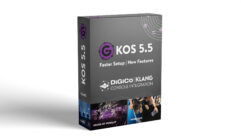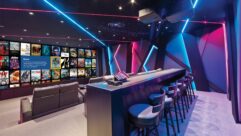
5 Star Cases Builds Case for World’s Largest Plasma Screen
Jan 16, 2007 12:00 PM

5 Star Cases has just completed the design and build of a specialist flight case for PSCo to house the world’s largest plasma screen.
At 103in. on the diagonal, the Panasonic TH-103 proved to be a challenge for 5 Star’s design team—but nothing the team couldn’t handle. After close consultation with PSCo, two cases were delivered to the exacting specification.
The plasma screen weighs in at a massive 484lbs. (220kg)—a factor taken into account when designing the case.
PSCo had a number of requests for 5 Star relating to the transportation and handling of the equipment.
Although only a slim 5.2in. (130mm) wide, the width of the case was set at 26in. (650mm) to ensure stability. The TH-103 does not include the usual grab handles featured on smaller plasma units—instead, three removable lifting eyelets are provided along the top edge of the screen, available for general hoisting.
However, with the size and delicacy of the screen, PSCo required a different approach to handling. Key to the case design was that it could accommodate a specialist manual hydraulic hoist (similar to a small fork-lift truck) that picks up the 103in. screen from the front, enabling it to be directly mounted onto a wall bracket.
To achieve this, 5 Star used its specialist 3D software, Solid Edge, to produce a realtime virtual case so they could get the design just right.
Because the Panasonic screen couldn’t be lifted directly under its bottom edge, 5 Star produced a special aluminium box section frame to support it. This TIG welded structure, also designed in Solid Edge, forms the backbone of the case, providing a strong, lightweight frame in which the screen sits. This entire structure is positioned on top of a rubber shock-mounted panel for transportation.
A low split base, as in 5 Star’s Super Tour specification case, enables the lift to pick up the screen at a relatively low level. This was achieved by designing a hinged flap along the front edge of the case. Due to the sheer size of the flight case, a split lid design was also incorporated which can be removed by just two people.
Although the screen is offset in the case, a wide wheelbase ensures stability while in transit—made necessary due to the protrusion of the wall mounting bracket. It’s held securely in the aluminum structure and foam support blocks are also fitted into the lid sections for additional protection while on the move. Once the lids are removed and the front flap is hinged down, the lift tines are positioned in line with two aluminum box sections on the frame. The hydraulic lift then raises the aluminium structure and 103in. screen and once clear, the base of the case is wheeled away. The lift then raises the screen to the desired height and is moved towards its wall bracket for fixing.
With the aluminum frame merely supporting the 103in. screen, once the plasma is hung on the wall bracket, the lift can be lowered clear and returned to the flight case.
“We have an excellent, long term relationship with 5 Star and have worked alongside them to produce specialist cases for a number of our products, including the 84in. [plasma screen] that needed a specialist lift stand,” says Stuart Holmes, managing director of PSCo. “The 103in. goes that much further in requiring fully mechanised lifting because of its sheer size and dimensions. As the official support partner for the 103in. screen for Panasonic, these cases are an instrumental part of us being able to service both the rental and installation markets—and with 5 Star’s support we were ready on time for the first installation of the product in a flagship John Lewis store.”
“This project was particularly challenging, due the sheer size, delicacy, and weight of the Panasonic screen,” adds 5 Star’s Phil Lawrence. “However, with the facilities now at our disposal, we can show clients it’s not just about ‘building boxes!'”










